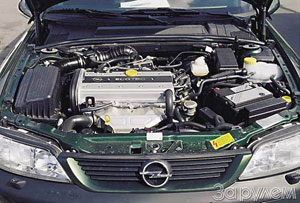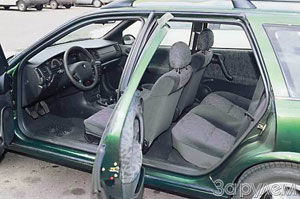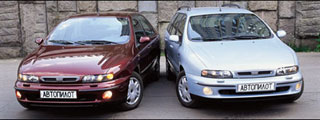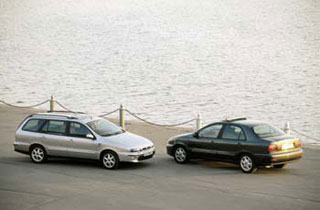Test Drive FIAT MAREA 1996 - 2002 Sedan
European Universal
The official debut of automotive innovations in Russia is usually 5-10 months after the European Premiere. It happened this time. In the spring - in the summer of Russian dealers there were three new universal of the middle class, adapted to our conditions. All of them in our test: Fiat Marea Weekend ($ 24,500), Opel Vectra-caravan ($ 34,000) and Peugeot 406 Break ($ \u200b\u200b20,576). Today, in the transport stream on our roads, foreign cars of universal appear on our roads. What matches a person who can upload $ 20-30 thousand to buy a car, stop their choice not on a sedan or coupe, but on a less prestigious utilitarian car? This may be a passion for traveling, the need to often transport the bulk sports equipment or another will like, finally, just a pragmatic mindset. Let's see what it is - a modern European wagon, comparing three new items.
Today, in the transport stream on our roads, foreign cars of universal appear on our roads. What matches a person who can upload $ 20-30 thousand to buy a car, stop their choice not on a sedan or coupe, but on a less prestigious utilitarian car? This may be a passion for traveling, the need to often transport the bulk sports equipment or another will like, finally, just a pragmatic mindset. Let's see what it is - a modern European wagon, comparing three new items. The nationality of cars is most pronounced in their appearance: Fiat is hotly hot, expressive, which is emphasized by original design decisions, Opel - German is restrained and functional, Peugeot in French Elegance. All the wagons are somewhat longer sedans, on the basis of which they are made, but the 406th is the most noticeable - break on a good quarter meter longer rivals.
Sixteen fiat fiat engines and Opel practically do not differ from those that are supplied to Europe. But Peugeot experts considered optimal for Russia, a simpler eight-flaped motor with a reduced degree of compression. The suspension of all cars has been refined - the ground clearance increases, and more rigid springs have a greater energy intensity. On the fiat, a thin plastic screen will protect the engine compartment only from splashes and dirt, on the Opel generously perforated steel sheet will protect against stones and corporate, and on the Peugeot Iron Sheet without any holes will provide the engine and purity, and invulnerability.
It is striking and the difference between powerful, long spars on the Opel and Peugeot and two flat, half-meter length, overlays in front of the bottom of the FIATA. It is probably that this largely can be explained that when one rear wheel of the Italian turns out to be on a ten-centimeter buccorku, the body is pulled out and the doors are closed with a metal knock.
 For the convenience of landing, disembarking, the whole trip can be raised satisfactory. On the weekend requires a lot of effort when closing doors - clap them like on a truck. By the way, it is this car that will like more than other scattered drivers: here the central lock will not work if one of the doors are loosely closed. In caravan, internal handles are forced until the brush is turned off. The break can boast of large doorways, but this advantage is compensated by uncomfortable outer door handles, in the Muscovite-2140 style, and the lack of door locking visible outside the outside buttons.
For the convenience of landing, disembarking, the whole trip can be raised satisfactory. On the weekend requires a lot of effort when closing doors - clap them like on a truck. By the way, it is this car that will like more than other scattered drivers: here the central lock will not work if one of the doors are loosely closed. In caravan, internal handles are forced until the brush is turned off. The break can boast of large doorways, but this advantage is compensated by uncomfortable outer door handles, in the Muscovite-2140 style, and the lack of door locking visible outside the outside buttons. The rear seat turned out to be the most closely at Fiat: here only two will be comfortable. The width of the cabin for the shoulders of three men of the average set is insufficient. True, hump on the back squeezes the middle passenger from the total number of ahead and thus makes it possible to deploy the shoulders almost without interference. The heads of the two extreme sedifts are close to located on the racks of rather solid lighting ceiling. The rear seat of Opel turned out to be unexpectedly spacious: significantly more space for feet and somewhat wider in shoulders. Threesome can be made already quite cozy, however, hump on the back, although smaller, is present here. Most luck is a Peugeot passengers - he has the most spacious salon. In addition, the backrest of the front seats are made with deepening, so that even in the extreme rear position they do not resume the knees of passengers of the second row. The back seat resembles a soft sofa without pronounced seats - three people will arrange here almost as comfortable as two. There was no central armrest on our 'Break at the back, but only he, unlike competitors, could boast of fully descending rear windows.
 All machines are equipped with five head restraints. At the weekend from behind, they do not interfere with the review, because it can be lowered with a back, and when it is unfolding, there is no need to dismantle. Only the central head restraint of the second row is reminded on the caravan, the four of the same hardness and dimensions are reminiscent of the fist. Trump headrest breaks - their softness.
All machines are equipped with five head restraints. At the weekend from behind, they do not interfere with the review, because it can be lowered with a back, and when it is unfolding, there is no need to dismantle. Only the central head restraint of the second row is reminded on the caravan, the four of the same hardness and dimensions are reminiscent of the fist. Trump headrest breaks - their softness. The front passenger will feel comfortable enough in all three cars. The glove box on the Italian machine is the most modest sizes. In German - narrow and deep as Nora. Open it is convenient only with your right hand, and the lid rests on the knees. The French is the most bulky basket, and also lockable on the castle.
The driver's Peugeot driver is faster, here are only two familiar mechanical adjustments. The driver of the Opel can, in addition, to move the seat up and down, and Fiat - also change the lumbar side - also manually. All chairs, including rather soft French, have good lateral support. Only on Opel is not provided for adjusting the height of the steering wheel. The gearbox lever is the easiest, perhaps, the 406th, but the handbrake turned out to be far from behind. On Marea-Weekend, the fourth gear and reverse are too close, and the armrest prevents reaching the parking brake. The Vectra has a blocking of the random turn on the reverse transmission: you need to raise the tape on the gearbox lever.
 The rest of the controls are traditional enough, and they immediately get used to them. An exception is perhaps only the overloaded right-hand drive switch on the Fiat - tribute to the rich configuration of the machine, but the sound signal button, located on Peugeot traditionally in French - in the end of the left steering wheel switch. In addition, lighting equipment is not entirely familiar on these two cars: on the first, when the ignition is turned off, all outdoor lighting goes out, including dimensions, on the second, with a similar operation, nothing comes, even distant headlights. On Opel, only the rotating position switch of the position of the inner mirror of the rear view, which requires more attention than the familiar lever. Overview of each car has its own characteristics. Marea-weekend does not see the edge of the hood and very massive racks. On Vecture, the edge of the hood is visible well, the racks are less massive, but the outer mirrors resemble the petals not only forms, but also the size. Overlook the surroundings from the 406th, perhaps most convenient. What is surprising - even three head restraints of the second row almost do not interfere with looking back. The only remark is the thick rear bodies.
The rest of the controls are traditional enough, and they immediately get used to them. An exception is perhaps only the overloaded right-hand drive switch on the Fiat - tribute to the rich configuration of the machine, but the sound signal button, located on Peugeot traditionally in French - in the end of the left steering wheel switch. In addition, lighting equipment is not entirely familiar on these two cars: on the first, when the ignition is turned off, all outdoor lighting goes out, including dimensions, on the second, with a similar operation, nothing comes, even distant headlights. On Opel, only the rotating position switch of the position of the inner mirror of the rear view, which requires more attention than the familiar lever. Overview of each car has its own characteristics. Marea-weekend does not see the edge of the hood and very massive racks. On Vecture, the edge of the hood is visible well, the racks are less massive, but the outer mirrors resemble the petals not only forms, but also the size. Overlook the surroundings from the 406th, perhaps most convenient. What is surprising - even three head restraints of the second row almost do not interfere with looking back. The only remark is the thick rear bodies.  A large comfortable trunk - the beauty and pride of the universal. The most spacious one is a peugey break, although the transformation options are only one, since the back of the rear seat on our car was one-piece. The size of 1820 mm formed during this place allows you to comfortably accommodate here for the night.
A large comfortable trunk - the beauty and pride of the universal. The most spacious one is a peugey break, although the transformation options are only one, since the back of the rear seat on our car was one-piece. The size of 1820 mm formed during this place allows you to comfortably accommodate here for the night. Located under the floor of the pendant spring provided weekend the largest space between the wheeled arches - 1030 mm. The two-section door allows you to transport very long flat loads, protruding in open opening only the bottom. Significant advantages When loading and unloading the boosted of moderate sizes, the folding regiment does not give, since the loading height is almost the same in all three cars, but it is necessary to stretch into the deposit on the luggage.
Opel-caravan has the trunk of the most modest size, but has the most wide in the top of the opening of the fifth door, which is very significant when transported, say, TV with a diagonal from meter and higher. Transformation options The two last machines are provided abound, since their rear seats are folded in proportions 40:60 (the narrow part is located on the left, and on the Opel - right). In addition, in the niches of central armrests there are hatches, convenient for transportation, such as skis. From above, all the trunks are covered with semi-rigid shelves. Under the floor - niches with full-size spare wheels, but mounted on simple iron disks. The tool is the most needed: jack, wheeled key, removable towing eye, sometimes - screwdriver.
 Various motors capacity has led to completely predicted differences in the dynamic qualities of cars. Add to it that FIATA has the most acute steering and a rigid suspension, which is sensitive to the quality of the road surface. Opel can boast short and clear moves of the gear lever. Peugeot has the most soft suspension, which delicately carries the car through all the Colds. But the course of the clutch is great, and some sort of trembling on the accelerator pedals. Yes, and the motor seems unnecessary loud, probably due to the lack of sound insulation on the inside of the hood.
Various motors capacity has led to completely predicted differences in the dynamic qualities of cars. Add to it that FIATA has the most acute steering and a rigid suspension, which is sensitive to the quality of the road surface. Opel can boast short and clear moves of the gear lever. Peugeot has the most soft suspension, which delicately carries the car through all the Colds. But the course of the clutch is great, and some sort of trembling on the accelerator pedals. Yes, and the motor seems unnecessary loud, probably due to the lack of sound insulation on the inside of the hood. Fiat and Opel in Europe are demanding demanding to the quality of gasoline - only unleaded 95th. Peugeot more complain and will satisfy the 92nd, and even eaten, since it does not have a catalytic neutralizer. All three models are given an annual warranty without a mileage limit. It is possible to implement it in Russia, respectively, on seven, four and three maintenance stations, the norm-hour of work on which costs 45, 36 and 43 dollars.
 The editors thanks the company Alfa-Romeo-Moscow, autoimport and Armand Peugeot
The editors thanks the company Alfa-Romeo-Moscow, autoimport and Armand Peugeot for the cars provided for test.
Meet the novelties of the Russian Universal Market (from left to right): Opel Vectra Caravan, Peugeot 406-Break, Fiat Marea Weekend.
Fiat appearance is the most avant-garde.
In the central part of the front panel - the magnetol fiat the original form.
Above the interior, the designers also worked on fame.
The 1.8-liter motor was considered optimal for Russia. Interesting feature: candles with individual ignition coils are stubborn under an additional upper engine cover.
Opel-caravan appearance is typical for the station wagon.
The speedometer marked up to 260 km / h is clearly designed for a more powerful car.
The cleanliness of door openings provides a triple seal at the top and double - down.
To obtain a more even torque characteristics in all motors of the ecotek series use intake collectors of alternating volume.
Who said that the universal can not be elegant?
The front panel and dashboard look too ascetic for the machine of this class. At the tachometer site - big clock.
As if in opposition to the meter width of the upper part, at the bottom, the opening of the back door is strongly aligned with the scallop around the wheel arch.
In front of a very tilted back of the engine quite a lot of empty space. The front spars corrugated in the nose is provided with the average strength of the collision crumpled by this motor compartment area, without prejudice to the power unit and the front suspension.
Fiat Marea-Weekend 1.8 16 V
 Technical characteristics of the car
Technical characteristics of the car General data: Number of places - 5; Curb weight - 1255 kg; full weight of 1850 kg; Maximum speed - 193 km / h; overclocking time up to 100 km / h - 10.6 s; fuel consumption at 90.120 km / h and in Hz - 6.0; 7.8; 10.1 l / 100 km; fuel supply - 63 l; Fuel - non-ethydrated gasoline AI-95.Mims, mm: Length - 4485; Width - 1740; Height - 1510; base - 2540; Pitch in front / rear - 1480/1455, Road clearance - 170; The volume of the trunk - 500/1550 l; Radius of rotation - 5.4 m. Engine: 16-valve 4-cylinder inline, with two camshafts and distributed electronic injection, located in front of the cross; Working volume - 1747 SMZ; cylinder diameter and piston stroke - 82.0 x 82.7 mm; The degree of compression is 10.3; Power - 83 kW / 113 hp at 5800 rpm; Maximum torque - 154 NM at 4400 rpm. Transmission: Drive on the front wheels; gearbox - mechanical five-speed; Transmission numbers: I - 3.91; II - 2.24; III - 1.52; IV - 1,16; V - 0.95; Z.Kh. - 3.91; Main gear - 3.56. Suspension: independent, with transverse stability stabilizers, is collected on subframes; Front - type Mac-Ferson, rear - on single longitudinal levers. Brakes: hydraulic, with vacuum amplifier and ABS; Front - ventilated discs, rear - drums. Steering: Rush with a hydraulicel. Tire size: 195/55R15

Fiat Marea-Weekend's five-door wagon and Fiat Marea four-door sedan debuted in July 1996, as a logical development presented a year earlier than the Bravo / Brava duo with the bodies of three- and five-door hatchback (SMS, 1996 No. 6.) Both vehicles can be equipped with gasoline Motors working volume 1.4; 1.6; 1.8 and 2.9 liters or 1.9- and 2.4-liter turbodiesels. Transmission - five-speed mechanical and four-stage automatic (only with an engine 1.6 liters).
+ Original design, sharp steering, good review back.
- Small rigidity of body body, rigid suspension, close from behind salon.
Summary
Temperament car for active ride on good roads.
Opel Vectra Caravan 2.0 16 V
 Technical characteristics of the car
Technical characteristics of the car General data: Number of places - 5; Curb weight - 1320 kg; Full weight - 1910 kg; Maximum speed - 207 km / h; overclocking time up to 100 km / h - 10.5 s; fuel consumption at 90.120 km / h and in Hz - 6.1; 7.6; 10.0 l / 100 km; fuel supply - 60 l; Fuel - unleaded gasoline AI-95. Dimensions, mm: Length - 4490; width - 1710; height - 1450; base - 2640; Pitch in front / rear - 1480/1470; Road clearance - 140; The volume of the trunk is 460/1490 l; Radius of rotation - 5.7 m. Engine: 16-valve 4-cylinder inline, with two camshafts and distributed electronic injection, located in front of the cross; Working volume - 1998 SMZ; cylinder diameter and piston stroke - 86.0 x 86.0; compression ratio - 9.2; Power - 100 kW / 136 hp at 5600 rpm; Maximum torque - 188 NM at 3200 rpm. Transmission: Drive on the front wheels; gearbox - mechanical 5-speed; Transmission numbers: I - 3.58; II - 1.88; III - 1.23; IV - 0.92; V - 0.74; z.h - 3.33; Main gear - 3.94. Suspension: independent, with transverse stability stabilizers, assembled on subframes, front-type Mac-Ferson, rear - triend. Brakes: hydraulic, with vacuum amplifier and ABS, disc, front - ventilated. Steering: Rush with a hydraulicel. Tire size: 195/65R15.

Wagon Opel Vectra-caravan was shown in August 1996, a year after entering the light of a new spectra with sedan and hatchback bodies. Engines - gasoline working volume 1.6; 1.8; 2.0 and 2.5 liters or 1.7 - and 2.0-liter turboodiesels. Transmission - five-speed mechanical or four-stage automatic (except for machines with an eight-boiled version of the motor 1.6 liters and diesel engines).
+ Wide at the top of the opening of the fifth door, good dynamic qualities.
- High price, uncomfortable door handles, rigid headrests.
Summary
Successful compromise between respectableness and practicality.
PEUGEOT 406-BREE 1.8
 Technical characteristics of the car
Technical characteristics of the car General Taxes: Number of Sites - 5; Curb weight - 1310 kg; Full weight - 1805 kg; Maximum speed - 185 km / h; overclocking time up to 100 km / h - 12.5 s; fuel consumption at 90.120 km / h and in Hz - 6.1; 7.6; 10.9 l / 10th km; Fuel supply - 70 l; Fuel - gasoline AI-92, let's say eateled. Dimensions, mm: Length - 4725; Width - 1760; height - 1500; base - 2700; Pitch in front / rear - 1500/1480, Road clearance - 180; The volume of the trunk - 525/1740 l; Radius of rotation - 6.0 m. Engine: 8-valve 4-cylinder inline, with distributed electronic injection, located in front of the cross; Working volume - 1761 CMZ; cylinder diameter and piston stroke - 83.0 x 81.4; compression ratio - 9.2; Power - 70 kW / 97 hp at 6000 rpm; Maximum torque - 145 NM at 3000 rpm. Transmission: Drive on the front wheels; gearbox - mechanical five-speed; Transfer numbers: i - 3.46; II - 1.87; III - 1.36; IV - 1.05; V - 0.80; z.h - 3.33; Main gear - 4.16. Suspension: independent, with transverse stability stabilizers, is collected on subframes; Front - type Mac-Ferson, rear - four-way. Brakes: hydraulic, with vacuum amplifier, front - ventilated discs, rear - drums. Steering: Rush with a hydraulicel. Tire size: 195/65R15.

The Universal Peugeot 406 Break was represented by the public in the fall of 1996, a little more than a year after the premiere of the new Peugeot 406 with a sedan body. These machines are installed gasoline engines with a working volume of 1.6 (except wagon); 1.8; 2.0 and 2.9 liters or 1.9- and 2,1-liter turboodizels. Gearboxes - five-speed mechanical or four-stage automatic (only with atmospheric versions of 2.0- and 2.9-liter motors).
+ Low price, spacious salon, soft suspension, 92th gasoline.
- Noisy motor, shivering accelerator pedals, ascetic interior.
Summary
Many car for moderate money. Calm, spacious family car.



Yuri Neduchov
Photo by Vladimir Knyazev
A source: Journal "Behind the wheel"







